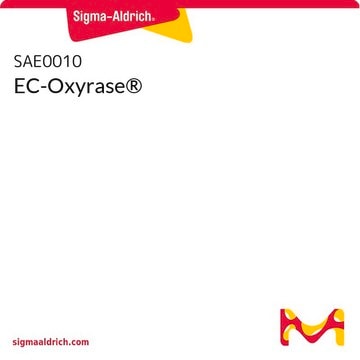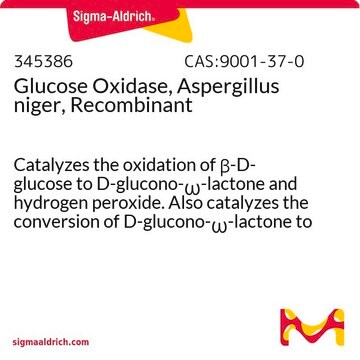추천 제품
생물학적 소스
bacterial (Pseudomonas spp.)
형태
lyophilized powder
특이 활성도
≥3 units/mg solid
분자량
~700 kDa
배송 상태
dry ice
저장 온도
−20°C
일반 설명
Protocatechuate 3,4-Dioxygenase belongs to the non-heme iron family of enzymes. The active site of the enzyme contains Fe3+.
애플리케이션
Protocatechuate 3,4-Dioxygenase(PCD), from Pseudomonas sp., is used for the enzymatic determination of choline esterase when coupled with phydroxybenzoate hydroxylase. It is used to improve organic fluorophore-stability in single-molecule experiments and is used to study the metabolism of protocatechuate in Rhizobiaceae.
The enzyme has been used to create an oxygen scavenging system along with protocatechuate (PCA) and Trolox. The enzyme employs a nonheme iron center that catalyzes the conversion of PCA and molecular oxygen into β-carboxy-cis,cis-muconic acid, while the antioxidant Trolox suppresses slow blinking and photobleaching of cyanine dyes. It has been used in the preparation of imaging buffer along with DMB-BSA (dynein motility buffer-BSA), ATP and protocatechuate in single molecule motility assay.
생화학적/생리학적 작용
Protocatechuate 3,4-Dioxygenase catalyzes the degradation of 3,4-dihydroxybenzoate (protocatechuate) into β-carboxy-cis,cis-muconate.
물리적 특성
Structure : Protein with nonheme iron
Inhibitors : Ag+, Hg++, PCMB
Optimum pH : 9.0
Optimum temperature : 60−65°C
pH Stability : pH 7.0−9.0 (25°C, 72hr)
Thermal stability : below 50°C (pH 6.0, 1hr)
Inhibitors : Ag+, Hg++, PCMB
Optimum pH : 9.0
Optimum temperature : 60−65°C
pH Stability : pH 7.0−9.0 (25°C, 72hr)
Thermal stability : below 50°C (pH 6.0, 1hr)
단위 정의
One unit will oxidize 1.0 μmole of protocatechuate to 3-carboxy-cis,cis-muconate per min at pH 7.5 at 37 °C.
물리적 형태
Supplied as lyophilized powder.
분석 메모
Protein determined by biuret.
Storage Class Code
11 - Combustible Solids
WGK
WGK 3
Flash Point (°F)
Not applicable
Flash Point (°C)
Not applicable
개인 보호 장비
Eyeshields, Gloves, type N95 (US)
시험 성적서(COA)
제품의 로트/배치 번호를 입력하여 시험 성적서(COA)을 검색하십시오. 로트 및 배치 번호는 제품 라벨에 있는 ‘로트’ 또는 ‘배치’라는 용어 뒤에서 찾을 수 있습니다.
이미 열람한 고객
Colin Echeverría Aitken et al.
Biophysical journal, 94(5), 1826-1835 (2007-10-09)
The application of single-molecule fluorescence techniques to complex biological systems places demands on the performance of single fluorophores. We present an enzymatic oxygen scavenging system for improved dye stability in single-molecule experiments. We compared the previously described protocatechuic acid/protocatechuate-3,4-dioxygenase system
G Trautwein et al.
Journal of bacteriology, 183(3), 873-881 (2001-02-24)
Protocatechuate degradation is accomplished in a multistep inducible catabolic pathway in Acinetobacter sp. strain ADP1. The induction is brought about by the transcriptional regulator PcaU in concert with the inducer protocatechuate. PcaU, a member of the new IclR family of
G K Podila et al.
Applied and environmental microbiology, 59(8), 2717-2719 (1993-08-01)
A heterologous gene probe encoding the alpha and beta subunits of the Pseudomonas cepacia protocatechuate 3,4-dioxygenase (PCD) was used to detect its homolog in the genome of Bradyrhizobium japonicum USDA110. Three cosmid clones carrying a 2.2-kb BamHI insert showed high
M Contzen et al.
Molecular microbiology, 41(1), 199-205 (2001-07-17)
The genes for a protocatechuate 3,4-dioxygenase (P34O-II) with the ability to oxidize 4-sulphocatechol were cloned from the 4-aminobenzenesulphonate(sulphanilate)-degrading bacterium Hydrogenophaga intermedia strain S1 (DSMZ 5680). Sequence comparisons of the deduced amino acid sequences of both subunits of the P34O-II from
Nicole Michelotti et al.
Methods in enzymology, 475, 121-148 (2010-07-16)
Recent improvements in methods of single-particle fluorescence tracking have permitted detailed studies of molecular motion on the nanometer scale. In a quest to introduce these tools to the burgeoning field of DNA nanotechnology, we have exploited fluorescence imaging with one-nanometer
자사의 과학자팀은 생명 과학, 재료 과학, 화학 합성, 크로마토그래피, 분석 및 기타 많은 영역을 포함한 모든 과학 분야에 경험이 있습니다..
고객지원팀으로 연락바랍니다.










